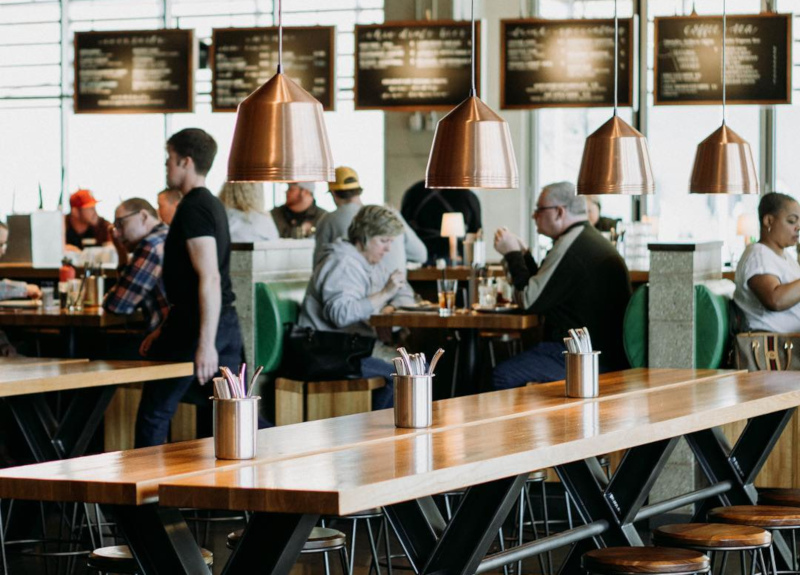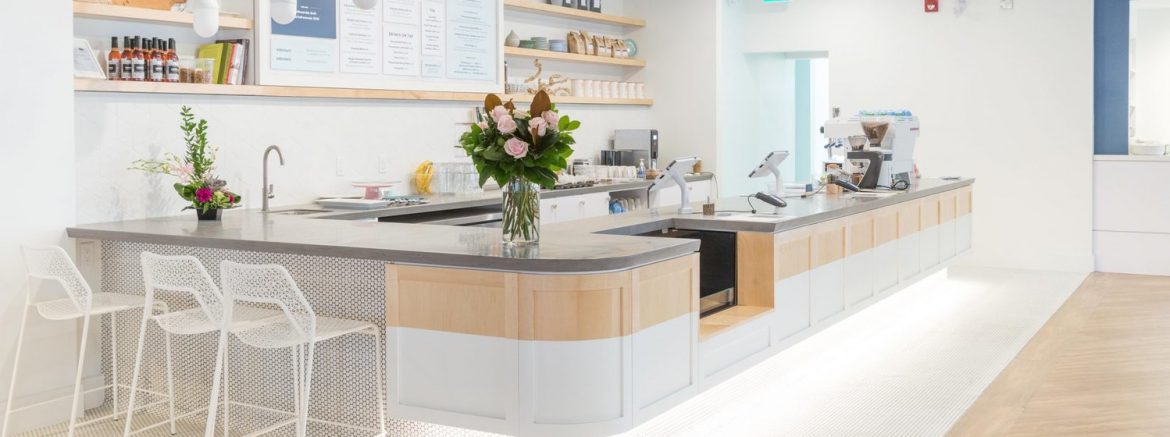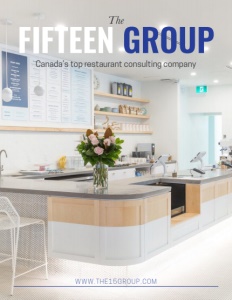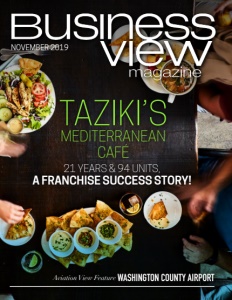The Fifteen Group
Canada’s top restaurant consulting company
Business View Magazine interviews representatives from The Fifteen Group, as part of our focus on the Canadian restaurant and hospitality sectors.
In 2001, with a background as a controller and financial analyst, David Hopkins launched his company, The Fifteen Group, which, today is North America’s premier full-service hospitality agency. “At the time, I knew a lot of people in the industry and I got asked to help a couple of restaurants that were struggling turning their revenues into profit,” he recounts. “I saw this opportunity, where it seemed like there were a lot of either independent restaurants in the marketplace, or small, multi-unit companies that were busy but were not making money because they really didn’t know how to run a business.”
In addition to consulting on how to help restaurants increase their bottom lines, within a year of its opening, The Fifteen Group began providing bookkeeping services, as well. “Not because I wanted to,” Hopkins avers, “but because the first five restaurants I consulted for had horrible books and I’m a very numbers-oriented person. For me, in terms of how we help restaurants make more money, books are a key part of it. I’m a big believer in budgets; I’m a big believer in monthly P&Ls that are accurate; and being able to have measurements in terms of where variances are and how the management team can work to improve those.”

David Hopkins, President
The next evolution of the company came about five years later. “We started getting involved in helping people open their restaurants,” Hopkins explains. “That was kind of by default, too, because we kept getting phone calls from people asking us to open restaurants for them. At that time, I’d been involved in opening 12 or 14 restaurants over my career, and my consultants had been involved in opening restaurants. We had a chef come onboard, as well, so we decided that we should get involved in that. Originally, it was just helping people who just needed guidance; we were holding people’s hands through the process because we’d done it many times, and most people that had come to us had not done it before, at all. So, that was our third revenue stream, and that’s grown in terms of what we offer.”
Two more offerings sprouted up in the ensuing years: the company started getting involved in concept development, branding, and graphic design. “And it’s to the point where we’ll do almost anything that’s required. And, in some instances, people will hire us to develop and launch a concept on their behalf. And that’s become a huge part of our business.” To date, the company has helped to develop and launch over 80 new restaurant concepts.
Then came managing restaurants for their owners. “We don’t actually manage the day-to-day operations, but we oversee the business for them,” Hopkins states. “So the general manager, or the chef, reports to us and we run that client’s business as if it’s our own. They realized that we could make a lot more profit; we could do a better job of ensuring customer experience – all the things that are important. So, it became a really great opportunity where we could go run their business and, generally, the increased profit from us running the business would completely offset our fee.”
So far, The Fifteen Group has worked with over 950 restaurants in the U.S. and Canada with service offerings that include branding and restaurant conception, operations management, staff training, menu development, kitchen design, financial consulting, and bookkeeping. And because the restaurant business is constantly evolving, The Fifteen Group has recently added yet another service. This past June, the company acquired Fervid Communications Inc., one of Canada’s top boutique hospitality-focused marketing agencies. This purchase adds comprehensive marketing services to the company’s portfolio of client offerings, transforming it into a complete, multidisciplinary agency for the restaurant industry.
“We still provide our core services to the businesses, but now we’ve added social media, marketing, photo shoots, and websites for our clients, as well, and we also handle all of their digital customer relations,” says Senior Public Relations Manager, Dean Harrison. “For instance, if a restaurant has a review on Yelp or any travel website, or Google Business, we help come up with, and construct, responses to those particular customers engaging with the brand. We also do full-service public relations for our clients: pitching them to the media; getting them on television, radio, and print; talking to the right journalists. Now, we can help our clients from start to finish – from helping them to create their brand to how they can operate and execute that brand, while extending and amplifying it to consumers and the media with a unified message.”
In yet another response to the ever-changing nature of the industry, The Fifteen Group has focused lately on sustainability initiatives, noticing how the millennial generation is driving the concept forward. “We’ve noticed that there’s been a significant shift in consumer behavior as the Millennials are coming of age,” Harrison notes. “Authenticity, transparency, and optics are now playing a critical role in the ongoing relationship with guests. So, we’ve come up with some tips that we’ve implemented within the operations of some of our clients, as well.”

One key initiative that the company promulgates is increasing the number and variety of plant-based food options on the menu, as consumers’ diets are clearly changing and many are moving away from animal-based meals. Then, there’s efficient menu development options in order to decrease waste and increase profits, such as designing a menu that cross-utilizes ingredients, or using one ingredient in multiple dishes and in many variations to ease labor, increase ordering execution, and reduce food waste. “Another key point that we’re suggesting is harnessing the power of technology,” Harrison adds. “Utilizing in-house sales, ordering software, and apps can dramatically improve forecasting sales and ingredient procurement.”
Finally, Harrison suggests having a “strict, but user-friendly, recycling policy” that consults with local community waste recycling programs to ensure that restaurants are properly recycling or composting their materials. “All of these initiatives are great in targeting Millennials,” he states. “One thing that can be missing, sometimes, though, is communicating these efforts; making sure that your guests understand what you’re doing from a policy perspective to ensure that you are a sustainable restaurant. That’s what we do in terms of social media application, developing websites, as well as press communication. We ensure that all these wonderful points that the restaurants are now focused on, and executing, are transferred through guest communication techniques.”
Hopkins believes that the restaurant industry is constantly challenging and that one of the greatest challenges, today, is the cost and availability of skilled labor. “Labor costs have gone through the roof, largely because of the minimum wage increases,” he reports. “And on top of that, just finding skilled labor is challenging, which drives labor costs up even more; if you can’t find skilled labor, you’ve got to pay more for the ones that are skilled. So, the profitability for restaurants becomes ever more challenging, and we’ve got to figure ways to combat that. And that leads right back into technology. Making use of technology, these days, does two things: it reduces the need for labor and it also reduces the need for skilled labor. If you can get by with unskilled labor doing the job that, six years ago, used to require skilled labor, that’s a huge thing.”
“It’s an interesting challenge for restaurants,” Hopkins continues, “because at the same time, consumers are demanding better and better from operations. If you look at the quick-serve market, 25 years ago, the best quick-serve thing you could get was a McDonald’s hamburger, whereas now, consumers are demanding better offerings than that. So, the challenge on the restaurant side is: how do I deliver a better experience for the guest without losing money in the process? That comes down to technology, as well as training processes, systems, and procedures in an operation. Unless you have everything systemized and processed, such that unskilled labor can do a skilled position, it makes it really hard.”
Jenny Companion, Vice President of Eastern Canada Operations adds some technology details. “There are a lot of really specific things that are happening,” she notes. “What we’re seeing having the biggest impact is the integration between the items that restaurants are using. And where they’re having the most success is taking scheduling platforms and integrating them directly with their POS (Point of Sale) systems to be able to do post-sales and have the system help forecast what a day-by-day can look like, as well as get real-time performance on how they’re doing with their plan.
“We’re also seeing the ability to completely integrate with their inventory systems to allow them to do all of their product ordering and forecast their usage that way. So now, smaller restaurant groups can work with different platforms that can integrate and give them the same type of information as the large corporations have, which is really helpful. What’s taking it to the next level is that there are now a lot of platforms where, fairly cost-effectively, restaurants can work with mobile app programs to train their staff. So much of what the staff has access to is on their phone, where we know they already live and breathe. So, it’s making all the information that they want their employees to have, completely accessible through mobile apps.”
“There continues to be more and more products coming out, both in the kitchen and from a point of sales point of view that can help with the whole technology revolution,” Hopkins adds. “We opened a restaurant about two years ago outside of Vancouver that has a pretty complex menu. But it’s all done through sous vide cooking (the process of sealing food in an airtight container—usually a vacuum sealed bag—and then cooking that food in temperature-controlled water), which allows this restaurant to do a much higher quality food with less skilled labor and a really simple execution. That’s one example where we’ve implemented a technology technique to see if we can make the model better, both in terms of quality for the guest, but also for profitability for the operation.”
Over the past several years, The Fifteen Group’s team of over 40 of the industry’s top consultants has serviced a wide array of restaurants. And now, with its new digital communications strategy and media relations arm, the company is looking to expand its footprint even further into eastern Canada and the U.S., as well, intent on working with both old and new stakeholders to increase their bottom-line profitability, while enhancing their customers’ dining experience.
AT A GLANCE
WHO: The Fifteen Group
WHAT: A full-service hospitality consulting agency
WHERE: Toronto, Ontario and Vancouver, British Columbia
WEBSITE: the15group.com



